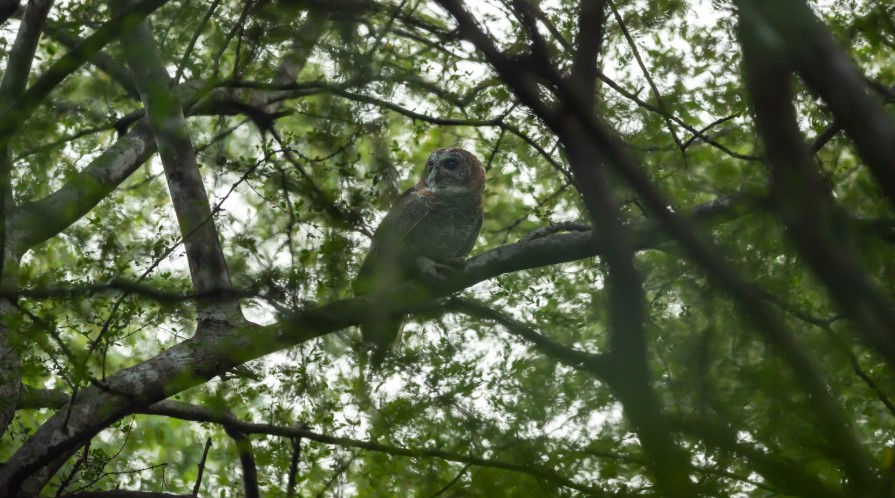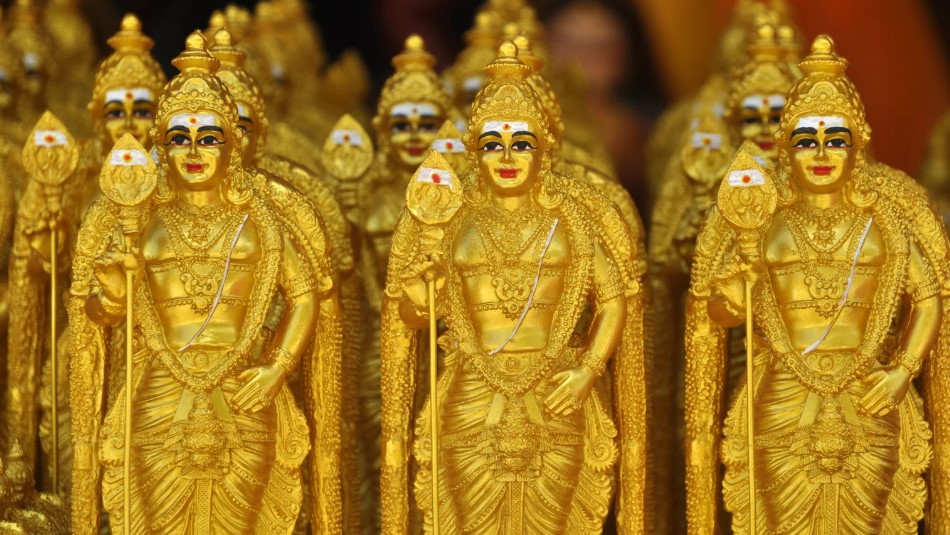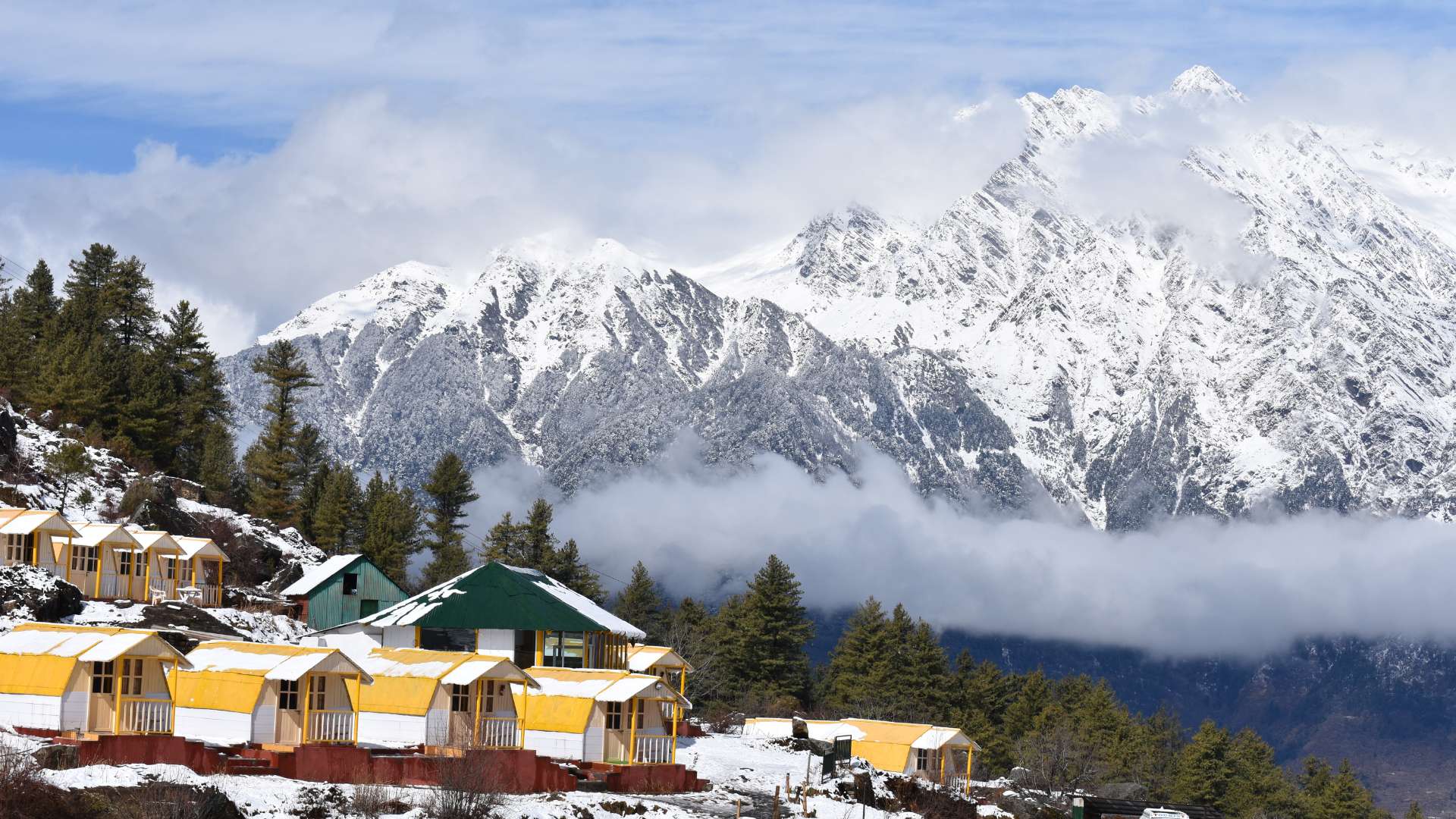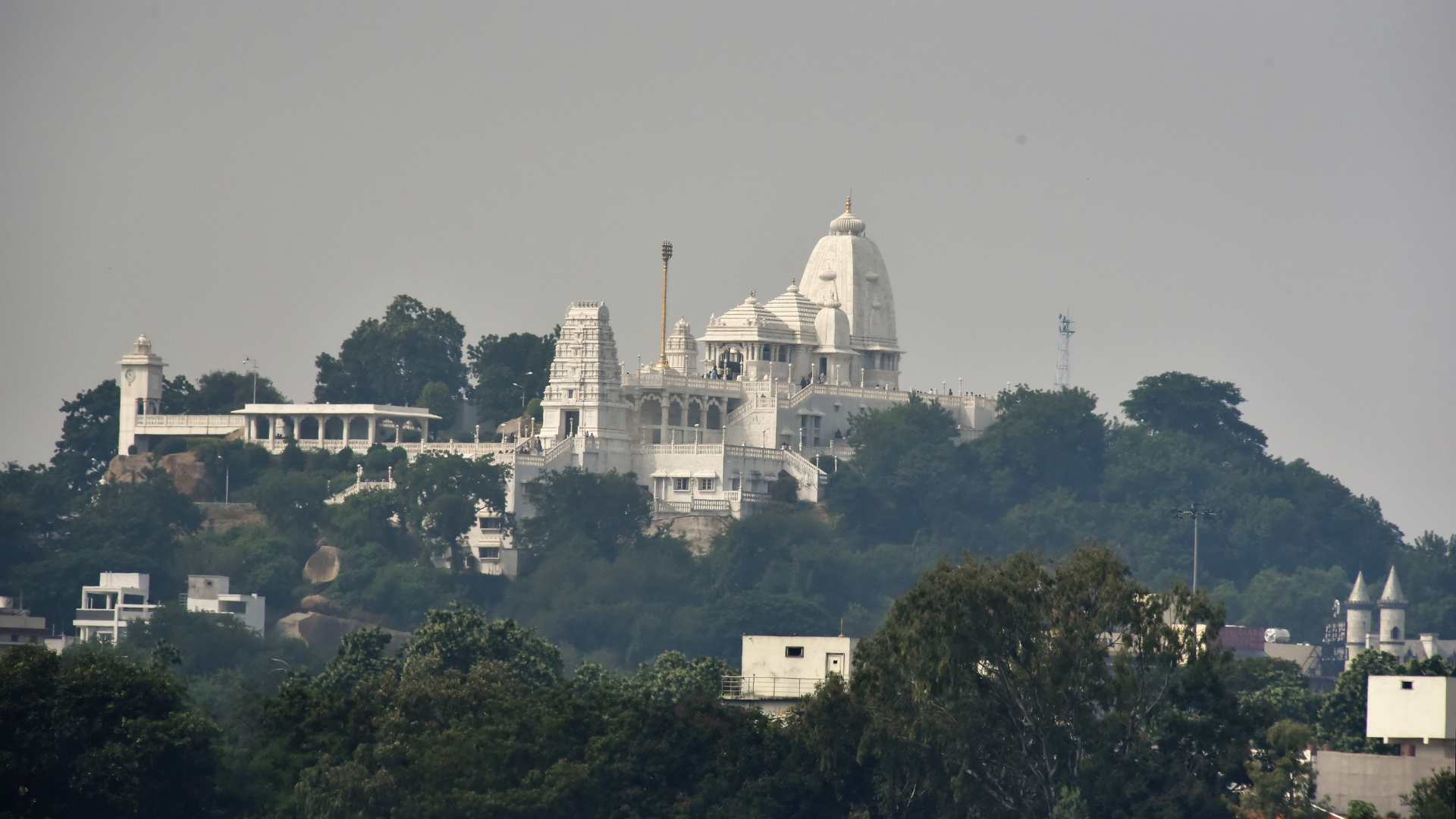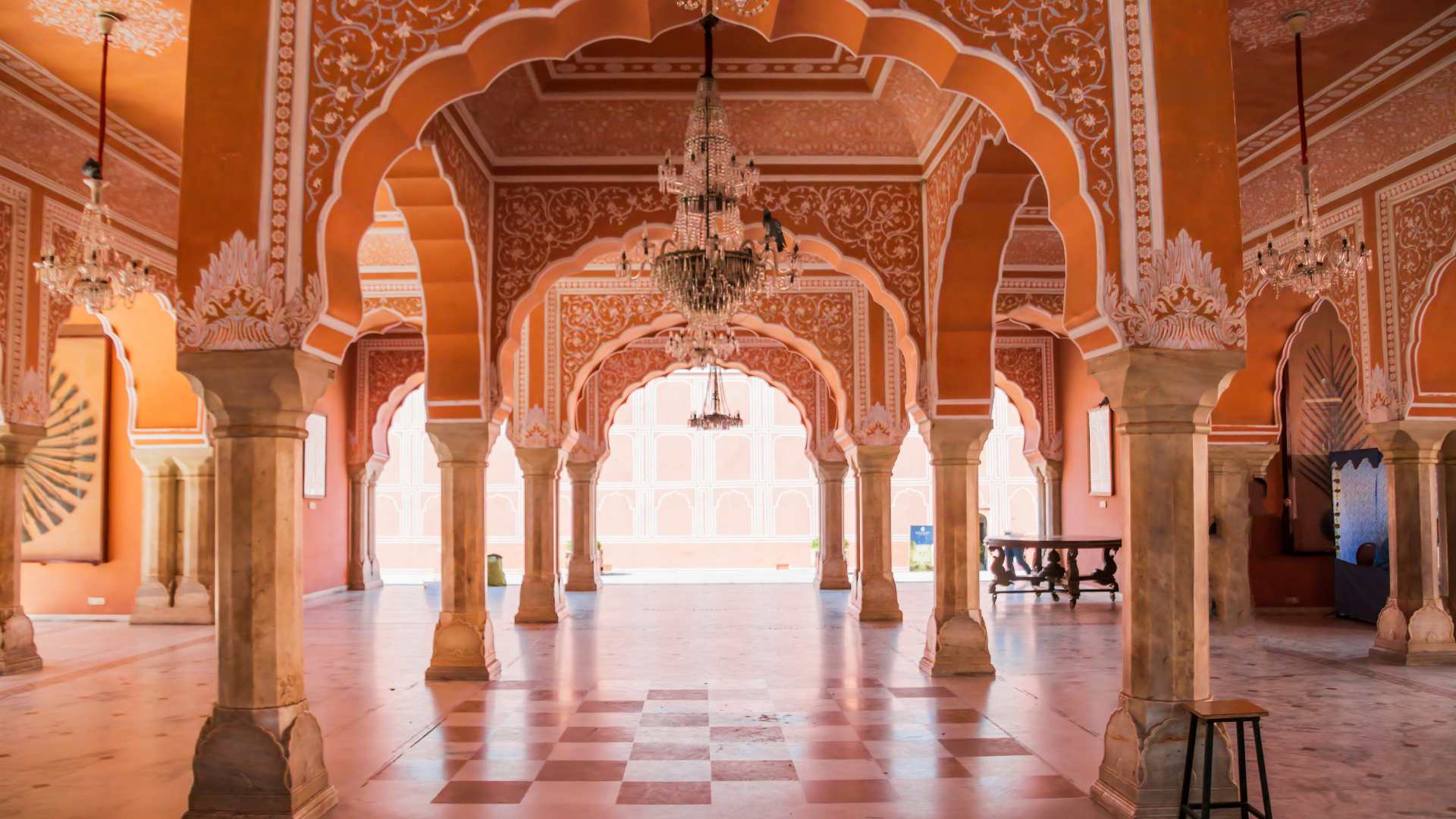Table of Contents
ToggleHave you ever wondered why India is known as the land of festivals? With a culture so diverse and traditions so deeply rooted, India celebrates countless festivals that highlight its rich heritage and unity in diversity.
From the vibrant, colour-splashed streets during Holi to the serene glow of lamps during Diwali, these celebrations bring people together, transcending regions and religions.
Each festival tells a unique story and reflects the country’s multifaceted traditions. But which festivals truly stand out among the rest?
Here, we explore India’s top 10 biggest festivals, delving into what makes each one iconic and special. Join us as we journey through a year of spectacular festivals defining this colourful nation’s spirit and heart.
Why Are Festivals Important in Indian Culture?
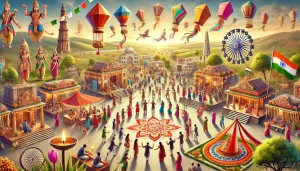
Festivals are essential to Indian culture because they reinforce social bonds and celebrate the country’s heritage.
They are moments of togetherness where people gather to share traditions, food, music, and rituals. Festivals mark important religious and seasonal milestones and offer a sense of continuity, linking generations through shared experiences.
They also highlight India’s core values of gratitude, unity, and resilience. From the grand Durga Puja in West Bengal to the simple yet heartfelt Rakshabandhan, festivals bridge the urban-rural divide and connect diverse communities.
Ultimately, these events foster a spirit of inclusion and celebrate the diversity that defines India.
How Do Indian Festivals Reflect Regional Diversity?
Indian festivals reflect the country’s immense regional diversity, showcasing unique customs and traditions across states.
For example, Diwali, known nationwide as the “Festival of Lights,” is celebrated differently in Tamil Nadu and Maharashtra.
Similarly, while Onam is Kerala’s main festival with elaborate pookalams (floral designs) and boat races, Baisakhi in Punjab features bhangra dances and nagar kirtans.
Even Holi, known for its colour play, takes on different forms, like the traditional Lathmar Holi in Uttar Pradesh.
This diversity stems from India’s rich history and varied cultural influences. Festivals honour local legends and beliefs and reinforce the idea that diversity strengthens unity.
What Common Traditions Do Indian Festivals Share?
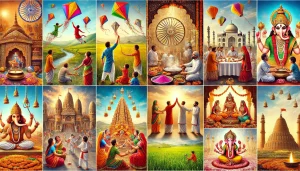
Despite the regional differences, Indian festivals share common traditions that highlight shared values and collective joy.
Most festivals include prayer rituals, family gatherings, and special foods that connect participants to their heritage.
Lights and decorations are standard in festivals like Diwali and Navratri, symbolizing hope and celebration.
Music and dance play central roles during events such as Garba in Navratri or folk performances during Baisakhi.
Gift-giving, acts of charity, and community participation are prevalent during Eid and Christmas. These shared customs demonstrate that Indian festivals, though diverse, embody similar themes of joy, gratitude, and social harmony.
How Do Indian Festivals Influence Tourism?
Indian festivals play a significant role in attracting global tourists. Events like Holi and Diwali are internationally known, drawing travellers eager to experience their vibrant celebrations firsthand.
Cultural festivals such as Navratri and Durga Puja showcase traditional music, dance, and arts, appealing to those interested in India’s heritage.
States like Goa see an influx of visitors for Christmas, while Kerala’s Onam pulls crowds for its unique rituals and feasts.
Festivals boost local economies through tourism, generating business for hotels, local markets, and artisans. The chance to witness these celebrations helps tourists understand India’s multifaceted culture and deep-rooted traditions.
What Are the Economic Impacts of Major Festivals?
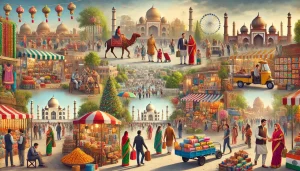
Indian festivals have substantial economic impacts that benefit various sectors. They drive consumer spending on clothing, jewellery, gifts, and sweets, especially during Diwali and Eid.
Markets see increased sales, while small businesses and artisans thrive due to the demand for traditional items like hand-made decorations and festive attire.
Festivals also boost tourism, as hotels, restaurants, and travel services see heightened activity. Additionally, festivals spur charitable donations and community events that support local economies.
This economic momentum sustains livelihoods, keeps cultural crafts alive, and promotes job creation. As a result, festivals in India are not just cultural milestones but vital economic drivers.
How Do Indian Festivals Promote Social Unity?
Indian festivals play a vital role in promoting social unity across different religions, castes, and communities.
Events like Diwali and Holi are celebrated by people of different backgrounds, transcending social and economic divisions.
Festivals provide a platform for shared experiences, fostering understanding and tolerance. During Christmas and Eid, it is common for non-Christians and non-Muslims to join in the celebrations, showcasing India’s inclusive spirit.
The communal rituals, such as breaking fast together during Eid or participating in langar (community meals) during Baisakhi, create bonds that reinforce unity.
These celebrations remind people that beneath the differences lies a shared love for tradition and community spirit.
Top 10 Biggest Festivals in India
1. Makar Sankranti/Pongal
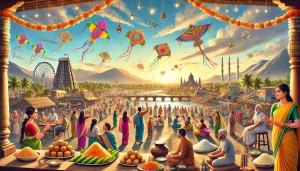
Makar Sankranti is a cherished festival that marks the sun’s transition into Capricorn, symbolizing the end of winter and the welcoming of longer days. Celebrated across India, it reflects the nation’s cultural richness through unique regional customs.
In Tamil Nadu, it is known as Pongal, a festival centered around expressing gratitude to the Sun God and cattle, crucial to the agricultural cycle.
Celebrations include prayers, festive home decorations, and the preparation of dishes such as Sakkarai Pongal, which is shared among families and communities as a token of prosperity.
In Andhra Pradesh and Telangana, the festival is celebrated enthusiastically, bringing together family and friends for feasts and traditional folk dances.
Homes are adorned with beautiful muggu (rangoli) designs, adding colour and vibrancy to the festivities. People prepare local delicacies, engage in rituals honouring the changing season, and exchange gifts to strengthen community bonds.
In other regions, such as Gujarat, kite-flying transforms the skies into a spectacle of colour, symbolizing freedom and joy.
Punjab celebrates the day as Maghi, with community gatherings, bonfires, and rituals that signify warmth and togetherness during the winter’s end.
Each state’s customs reflect the festival’s overarching themes of renewal, gratitude, and shared joy, highlighting India’s deep connection to its agricultural heritage and the unity these celebrations foster.
Makar Sankranti showcases the profound respect for nature and tradition that characterizes Indian festivals. The festival is a testament to the country’s enduring spirit of community and celebration, whether through the ceremonial offerings to the Sun God or the lively dances and communal meals.
Makar Sankranti/Pongal Festival Overview
| Aspect | Details |
| Festival Names | Makar Sankranti, Pongal, Uttarayan, Maghi |
| Date | Annually, on January 14th or 15th |
| Significance | Harvest festival marking the sun’s transition into Capricorn |
| Duration | 1 to 4 days, varying by region |
| Regions Celebrated | Tamil Nadu, Maharashtra, Gujarat, Punjab, Assam |
| Main Deities Worshipped | Sun God (Surya), cattle |
| Key Rituals and Activities | Kite-flying, community feasts, decorating cattle, holy dips |
| Traditional Foods | Til laddoo, Sakkarai Pongal, Venn Pongal |
| Alternate Names | Uttarayan, Maghi |
| Related Festivals | Lohri, Bhogali Bihu |
2. Maha Shivratri and Holi
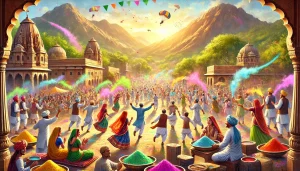
Holi, known as the “Festival of Colors,” is celebrated with exuberance throughout India and symbolizes the arrival of spring and the victory of good over evil.
The festival begins with Holika Dahan, a ritual bonfire that commemorates the legend of Prahlada’s unwavering devotion and the defeat of Holika.
The next day, known as Rangwali Holi, is marked by joyous revelry where people smear each other with vibrant coloured powders, sing, and dance in the streets.
In Uttar Pradesh, especially in Mathura and Vrindavan, Holi is celebrated with unmatched grandeur, featuring traditional plays that reenact scenes from Lord Krishna’s life.
In states like West Bengal, the celebration, known as Dol Jatra, takes on a more devotional tone with rituals and processions.
This festival unites communities, transcending social and economic barriers and fostering an atmosphere of fun, laughter, and togetherness.
Maha Shivratri and Holi Festival Overview
| Aspect | Details |
| Festival Names | Maha Shivratri, Holi |
| Date | February/March (Shivratri), March (Holi) |
| Significance | Devotion to Lord Shiva; celebration of good over evil (Holi) |
| Duration | 1 day for Maha Shivratri, 2 days for Holi |
| Regions Celebrated | Nationwide, with prominence in Varanasi, Mathura |
| Main Deities Worshipped | Lord Shiva (Shivratri) |
| Key Rituals and Activities | Fasting, night vigils, temple rituals (Shivratri), colour play, bonfires (Holi) |
| Traditional Foods | Gujiya, thandai, milk-based offerings |
| Alternate Names | Festival of Colors (Holi), Shivratri |
| Related Festivals | Lathmar Holi, Choti Holi |
3. Baisakhi
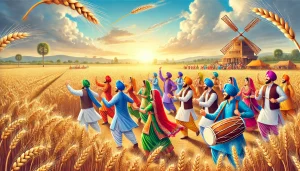
Baisakhi is an important harvest festival, especially in Punjab and northern India, which is celebrated to mark the harvesting of the rabi crops.
For Sikhs, it holds even greater religious significance as it commemorates the founding of the Khalsa by Guru Gobind Singh, establishing the community’s core values of equality and courage.
The day begins with early morning prayers in gurudwaras, where the Guru Granth Sahib is read, and hymns are sung to inspire devotion.
Traditional bhangra and gidda dances performed to the beat of dhols add a lively touch to the festival, showcasing Punjabi culture’s rich vibrancy.
People dress in colourful attire, participate in processions known as nagar kirtans, and enjoy community meals known as langar that reinforce the values of sharing and unity.
Beyond Punjab, Baisakhi is also celebrated as a time of joy and gratitude for nature’s bounty.
Baisakhi Festival Overview
| Aspect | Details |
| Festival Names | Baisakhi, Vaisakhi |
| Date | April 13th or 14th |
| Significance | Marks the Sikh New Year and harvest of rabi crops |
| Duration | 1 day |
| Regions Celebrated | Punjab, Haryana, Himachal Pradesh |
| Main Deities Worshipped | None (Sikh significance) |
| Key Rituals and Activities | Nagar kirtans, bhangra, community prayers, langar meals |
| Traditional Foods | Karah Prasad, festive meals |
| Alternate Names | Vaisakhi |
| Related Festivals | Bihu, Pohela Boishakh |
4. Eid-ul-Fitr
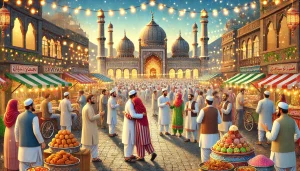
Eid-ul-Fitr, also known as the “Festival of Breaking the Fast,” marks the end of Ramadan, a month-long period of fasting and devotion observed by Muslims worldwide.
This festival embodies gratitude, communal harmony, and compassion. Celebrations begin with a special prayer called Eid Salah, held at mosques and open spaces.
Families dress in their best clothes and gather for meals that feature dishes like seviyan (sweet vermicelli), biryani, and kebabs.
In states like Kerala, Uttar Pradesh, and West Bengal, the festival is celebrated with fervour, where community feasts and acts of charity are a common sight.
People visit friends and relatives, exchange gifts, and share meals, strengthening bonds of friendship and love.
The day promotes unity, as acts of zakat (charity) highlight the importance of giving back to society and supporting those in need, reinforcing a spirit of empathy and gratitude.
Eid-ul-Fitr Festival Overview
| Aspect | Details |
| Festival Names | Eid-ul-Fitr, Meethi Eid |
| Date | Determined by lunar sighting |
| Significance | Marks the end of Ramadan, a time for gratitude and charity |
| Duration | 1 day |
| Regions Celebrated | Pan-India, notably in Hyderabad, Lucknow, Delhi |
| Main Deities Worshipped | None (Islamic festival) |
| Key Rituals and Activities | Fasting, Eid Salah, zakat, feasting, visiting friends and family |
| Traditional Foods | Seviyan, biryani, kebabs |
| Alternate Names | Festival of Breaking the Fast |
| Related Festivals | Eid al-Adha |
5. Rakshabandhan and Janmashtami
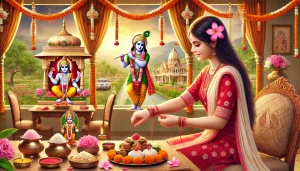
Rakshabandhan is a cherished festival that celebrates the bond between brothers and sisters, symbolizing love, protection, and mutual respect.
On this day, sisters tie a sacred thread known as a rakhi around their brothers’ wrists, a gesture that signifies their prayers for their brothers’ well-being.
In return, brothers offer gifts and pledge to protect their sisters. The festival is marked by family gatherings, the exchange of sweets, and a sense of unity that reinforces familial ties.
Rakshabandhan is particularly popular in northern and central India, including states like Uttar Pradesh, Rajasthan, and Madhya Pradesh.
Janmashtami, celebrated shortly after, commemorates the birth of Lord Krishna, an avatar of Lord Vishnu. The festival is observed with devotion, fasting, and night-long vigils as devotees chant hymns and reenact episodes from Krishna’s life.
In states like Uttar Pradesh (Mathura and Vrindavan) and Maharashtra, special rituals include the Dahi Handi event, where groups form human pyramids to break a pot of curd tied high above, recreating Krishna’s playful mischief as a child.
Homes and temples are decorated, and stories of Krishna’s teachings are recited, instilling values of love, resilience, and devotion.
Both Rakshabandhan and Janmashtami celebrate family, faith, and the importance of enduring bonds, bringing communities together in joy and devotion.
Rakshabandhan and Janmashtami Festival Overview
| Aspect | Details |
| Festival Names | Rakshabandhan, Janmashtami |
| Date | August |
| Significance | Rakshabandhan: Celebration of sibling bonds; Janmashtami: Birth of Lord Krishna |
| Duration | 1 day each |
| Regions Celebrated | Nationwide |
| Main Deities Worshipped | Lord Krishna (Janmashtami) |
| Key Rituals and Activities | Tying rakhi, fasting, temple visits, Dahi Handi |
| Traditional Foods | Kheer, peda, butter-based dishes |
| Alternate Names | Rakhi Purnima (Rakshabandhan), Gokulashtami (Janmashtami) |
| Related Festivals | Bhai Dooj |
6. Onam and Ganesh Chaturthi
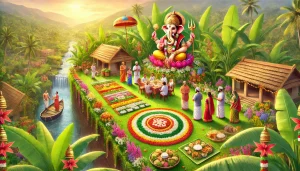
Onam is Kerala’s grandest festival, marking the legendary homecoming of King Mahabali, whose reign is remembered for prosperity and harmony.
Celebrated with immense fervour, Onam highlights Kerala’s rich cultural heritage through activities such as the creation of intricate pookalam (floral rangoli) designs, traditional music, and vibrant dances like Thiruvathira and Kathakali.
The highlight of the festival is the grand Onam Sadhya, a multi-course vegetarian feast served on banana leaves, featuring dishes like avial, sambar, and payasam.
Traditional boat races, known as Vallam Kali, draw large crowds and add to the excitement. Onam embodies themes of unity, gratitude, and celebration of nature’s abundance.
Ganesh Chaturthi, widely celebrated in Maharashtra, Karnataka, and other parts of India, marks the birth of Lord Ganesha, the deity of wisdom and remover of obstacles.
Communities and families install intricately crafted clay idols of Ganesha in their homes and public spaces, accompanied by daily prayers and aartis.
The festival fosters a sense of community through cultural performances, music, and sharing Ganesha’s favourite sweet, modak.
On the final day, the idols are taken in processions and immersed in water in a ceremony known as Visarjan, symbolizing Ganesha’s return to Mount Kailash and the cycle of life and renewal.
Ganesh Chaturthi is a time for prayer, joy, and the reaffirmation of faith, bringing people together in a spirit of devotion and festivity.
Onam and Ganesh Chaturthi Festival Overview
| Aspect | Details |
| Festival Names | Onam, Ganesh Chaturthi |
| Date | September |
| Significance | Onam: Harvest festival celebrating King Mahabali’s return; Ganesh Chaturthi: Birth of Lord Ganesha |
| Duration | 10 days each |
| Regions Celebrated | Kerala (Onam), Maharashtra (Ganesh Chaturthi) |
| Main Deities Worshipped | King Mahabali (Onam), Lord Ganesha |
| Key Rituals and Activities | Floral decorations, boat races, Onam Sadhya (Onam); idol immersion, prayers (Ganesh Chaturthi) |
| Traditional Foods | Onam Sadhya, modak |
| Alternate Names | Thiruvonam (Onam), Vinayaka Chaturthi |
| Related Festivals | Vishu (Kerala), Sankashti Chaturthi |
7. Navratri, Dussehra, and Durga Puja
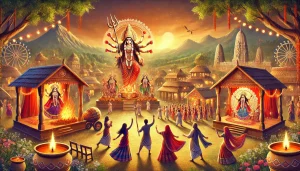
Navratri is a nine-day festival celebrated in honour of Goddess Durga and her nine divine forms, symbolizing the victory of good over evil.
Fasting, prayers, and elaborate rituals mark the festival across India. In Gujarat and Maharashtra, Navratri is synonymous with the energetic Garba and Dandiya Raas dances, where communities gather in traditional attire to dance in celebration.
Each night is devoted to a different form of the goddess, invoking blessings for strength, prosperity, and protection.
Dussehra, also known as Vijayadashami, follows Navratri and commemorates Lord Rama’s victory over the demon king Ravana.
This festival is celebrated with great enthusiasm in northern states like Uttar Pradesh and Delhi, where large effigies of Ravana are set ablaze, symbolizing the triumph of good over evil.
Dussehra processions and dramatic reenactments of the Ramayana bring communities together, showcasing themes of courage and righteousness.
Simultaneously, Durga Puja in West Bengal is a grand affair that celebrates the goddess’s victory over the buffalo demon Mahishasura.
Elaborate pandals are constructed, displaying beautifully crafted idols of Goddess Durga. The celebrations are marked by traditional dhunuchi dance, cultural performances, and community feasts.
Devotees engage in prayers and rituals that create a sense of spiritual renewal and collective joy. This period underscores the themes of resilience, devotion, and the eternal triumph of good over evil, uniting people in reverence and festivity.
Navratri, Dussehra, and Durga Puja Festival Overview
| Aspect | Details |
| Festival Names | Navratri, Dussehra, Durga Puja |
| Date | October |
| Significance | Worship of Goddess Durga, Lord Rama’s victory over Ravana |
| Duration | 9 days (Navratri), 1 day (Dussehra), 5 days (Durga Puja) |
| Regions Celebrated | Gujarat (Navratri), West Bengal (Durga Puja), North India (Dussehra) |
| Main Deities Worshipped | Goddess Durga, Lord Rama |
| Key Rituals and Activities | Fasting, Garba dances, effigy burning (Dussehra), idol immersion (Durga Puja) |
| Traditional Foods | Kuttu ki puri, sabudana khichdi, Bengali sweets |
| Alternate Names | Vijayadashami, Sharad Navratri |
| Related Festivals | Ram Navami, Maha Ashtami |
8. Diwali
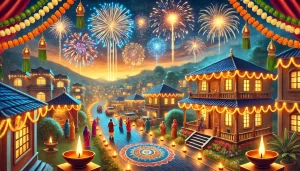
Diwali, known as the “Festival of Lights,” is one of India’s most widely celebrated and cherished festivals. It symbolizes the triumph of light over darkness and good over evil, rooted in the epic tale of Lord Rama’s return to Ayodhya after 14 years of exile and his victory over the demon king Ravana.
This festival unites people across the country with diverse customs that vary by region but share a common essence of joy and renewal.
Preparations for Diwali begin days in advance, with homes being cleaned and decorated with intricate rangoli designs and oil lamps (diyas).
On the night of the main celebration, families light these lamps to drive away darkness and welcome prosperity and positivity.
The festival also includes worshipping Goddess Lakshmi, the deity of wealth and prosperity, with prayers for health and fortune.
Diwali is marked by the exchange of gifts, sharing of sweets like kaju katli and ladoos, and bursting of firecrackers that light up the night sky.
In states such as Maharashtra and Gujarat, the festival lasts for several days and includes rituals like Narak Chaturdashi and Bhai Dooj.
Beyond the revelry, Diwali embodies themes of gratitude, the victory of good, and the renewal of relationships and community spirit, making it a time for togetherness and celebration.
Diwali Festival Overview
| Aspect | Details |
| Festival Names | Diwali, Deepavali |
| Date | October/November |
| Significance | Symbolizes victory of light over darkness, return of Lord Rama |
| Duration | 5 days |
| Regions Celebrated | Entire India with variations |
| Main Deities Worshipped | Goddess Lakshmi, Lord Ganesha, Lord Rama |
| Key Rituals and Activities | Lighting diyas, firecrackers, Lakshmi Puja, exchange of gifts |
| Traditional Foods | Kaju katli, ladoos, samosas |
| Alternate Names | Deepavali |
| Related Festivals | Kali Puja (Bengal), Bandi Chhor Divas (Sikhism) |
9. Guru Nanak Jayanti (Gurpurab)
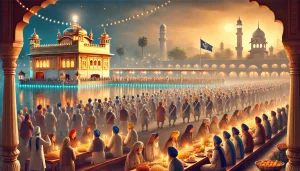
Guru Nanak Jayanti, also known as Gurpurab, is a revered festival celebrating the birth of Guru Nanak Dev Ji, the founder of Sikhism and the first of the ten Sikh Gurus.
This festival is an important occasion for Sikhs worldwide and embodies the teachings of Guru Nanak, which emphasize equality, humility, and service to humanity.
The day is marked by devotion, reflection, and community activities that unite people in a spirit of unity.
The celebrations often start with Prabhat Pheris, early morning processions, and devotional singing and recitals from the Guru Granth Sahib.
Special services in gurudwaras include reading the Akhand Path, a 48-hour continuous recitation of the Sikh holy book.
Community meals known as langar are prepared and served by volunteers, reflecting the principles of selfless service and equality taught by Guru Nanak.
Homes and gurudwaras are illuminated, and hymns (kirtans) are performed throughout the day to inspire devotion.
Processions featuring the Sikh flag (Nishan Sahib), martial arts demonstrations, and decorated floats depicting scenes from Guru Nanak’s life are common.
Guru Nanak Jayanti is a day that encapsulates the values of compassion, devotion, and communal harmony, encouraging reflection on a life of service and spiritual connection.
Guru Nanak Jayanti Festival Overview
| Aspect | Details |
| Festival Names | Guru Nanak Jayanti, Gurpurab |
| Date | November (based on the lunar calendar) |
| Significance | Marks the birth of Guru Nanak Dev Ji, founder of Sikhism |
| Duration | 1 day, with preceding processions and continuous recitals |
| Regions Celebrated | Predominantly in Punjab, Haryana, and Sikh communities worldwide |
| Main Deities Worshipped | None (spiritual observance honoring Guru Nanak) |
| Key Rituals and Activities | Prabhat Pheris, Akhand Path, community service, langar |
| Traditional Foods | Langar meals including dal, roti, and kheer |
| Alternate Names | Gurpurab |
| Related Festivals | Baisakhi, Hola Mohalla |
10. Christmas
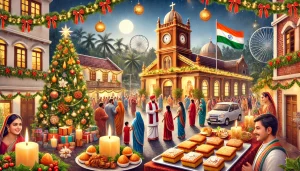
Christmas is celebrated to commemorate the birth of Jesus Christ and is one of the most significant festivals for Christians worldwide, including in India.
Preparations for Christmas often start weeks in advance, with homes and churches decorated with lights, Christmas trees, nativity scenes, and wreaths.
In states like Goa, Kerala, and parts of the Northeast, Christmas is celebrated with grandeur, including midnight Mass services at churches where communities gather to sing hymns and carols, share prayers, and listen to sermons that recount the story of Christ’s birth.
The Mass is a time of deep spiritual reflection and celebration, fostering a sense of togetherness and peace.
Festive meals are an integral part of Christmas, with families preparing special dishes like roast meats, plum cake, and cookies.
Gifts are exchanged, and acts of charity are performed, reflecting the festival’s message of love and goodwill.
Caroling, visiting friends and family, and community events add to the cheerful atmosphere. Christmas in India is a blend of religious devotion, cultural celebration, and universal themes of hope, spreading warmth and joy in communities nationwide.
Christmas Festival Overview
| Aspect | Details |
| Festival Names | Christmas |
| Date | December 25th |
| Significance | Celebrates the birth of Jesus Christ |
| Duration | 1 day |
| Regions Celebrated | Goa, Kerala, Mumbai, parts of Northeast India |
| Main Deities Worshipped | Jesus Christ |
| Key Rituals and Activities | Midnight Mass, carol singing, decorating Christmas trees |
| Traditional Foods | Plum cake, roasted meats, cookies |
| Alternate Names | Bada Din |
| Related Festivals | Advent, New Year’s Eve |
Conclusion
India’s top 10 festivals are more than just celebrations. They are windows into the soul of a nation known for its warmth and inclusivity.
Each festival, from Makar Sankranti in January to Christmas in December, carries a deep cultural and spiritual meaning, creating cherished moments that unite families and communities.
These festivals highlight India’s rich cultural tapestry and symbolize values such as gratitude, love, and the triumph of good over evil.
Experiencing these celebrations is witnessing the true vibrancy of Indian life, where tradition and modernity intertwine seamlessly.
Whether you participate in Holi’s joyous colours or Diwali’s glowing lights, these festivals remind us that every moment is an opportunity to celebrate life and share happiness in India.
FAQs About Top 10 Biggest Festival in India
What is the most celebrated festival in India?
Diwali, known as the Festival of Lights, is the most celebrated festival in India. It is observed nationwide with lights, fireworks, and family gatherings, symbolizing the victory of good over evil.
Why is Holi called the festival of colours?
Holi is called the festival of colours because people playfully throw coloured powders, signifying the joyous victory of good over evil and the arrival of spring.
Which festival marks the harvest season in India?
Makar Sankranti, Pongal, and Baisakhi mark the harvest season, celebrating agricultural abundance and expressing gratitude to nature and deities.
How do Indian festivals boost tourism?
Indian festivals like Holi and Diwali attract tourists globally, showcasing vibrant cultural traditions, boosting local economies, and promoting heritage tourism.
What makes Diwali special?
Diwali is special for its significance of light overcoming darkness, involving the lighting of lamps, prayers to Goddess Lakshmi, and the spirit of joy and prosperity.
What rituals are common in Navratri?
Navratri rituals include fasting, performing Garba or Dandiya dances, and worshipping different forms of Goddess Durga over nine days, ending with Dussehra.
How do festivals promote social harmony?
Festivals in India promote social harmony by bringing people of various backgrounds together in shared celebrations, fostering understanding and unity across communities.



